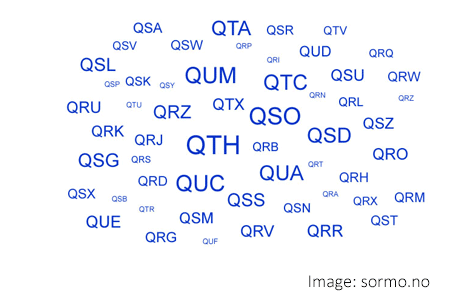This is a free fortnightly newsletter about the New Zealand Net.
If you would like to be notified by email when a new edition is published, please subscribe here.
Browse our Newsletter Archive and List of Net Tips.
Featured key

Photo: VK2IXV
By Herman VK2IXV
I obtained this rare New Zealand-made McCarthy bug via Trade Me last month.
These bugs were sold in the 1960s by A&W McCarthy in Dunedin. The McCarthy store sold straight and semi-automatic Morse keys, Minstrel radios, guns and outdoor equipment.

In this photo the extra weight has been moved from its storage position on the base onto the top of the standard weight on the key’s pendulum.
The McCarthy bug is a clone of the Vibroplex Lightning bug, but compared to a Lightning it feels extremely light, weighing only 801 grams!
By comparison, a Lightning with black crinkle base weighs 1696 grams, with grey crinkle base 1610 grams and with chrome base 1723 grams.
The McCarthy bug measurements are 16 x 7.5 x 1.5 cm.
On the front, under the finger pieces, it has a plastic name plate with “A & W McCarthy, Dunedin & Invercargill” on it.
On the left-hand side of the base, opposite the terminals, sits a small round weight on a washer to protect the paint on the base. This can be used to slow down the bug even more.
The bug has a light-green painted alloy base. Other McCarthy bugs have been seen with red or black bases.
Learn more about this type of key at the NZ Morse Key Directory.
Quick notes

The Maritime Radio Historical Society’s annual Night of Nights was held on 13 July at coast station KPH near San Francisco. You can read about it in the latest MRHS newsletter. I also recommend this short video of some really nice bug sending during the event by Wally Pugh (pictured), one of the KPH operators.
From the Graeme News Desk: Graeme ZL1BDS did his first session as Net Control recently and we hope to have him back again soon. Meanwhile, Graeme ZL2TE has put up the inverted-L aerial at his new retirement village home, and is now sorting out his rig and antenna tuning in preparation for returning to NZ Net on a regular basis.
International Lighthouse/Lightship Weekend is this weekend, 0001 UTC 16 August to 2400 UTC 17 August 2025 (48 hours). If you’re taking part, please consider sending some photos and a short article for the next NZ Net News. And here’s a list of the NZ lighthouses with their ILLW numbers.
The New Zealand HF Net Directory has had an upgrade. You can now browse the net list by day and time, as well as by net type and name.
AST SpaceMobile is pushing back against thousands of complaints that the company’s satellites risk interfering with amateur radio operations across the globe. The company has sent a letter to the US Federal Communications Commission, defending its plan to use the 430-440 MHz radio band outside the US to track and control its fleet of 248 satellites.
Photo flashback

Photo: NZPO Napier Radio Depot staff
In honour of International Lighthouse/Lightship Weekend, here’s a view of East Cape Lighthouse with its two radio towers in the 1960s. The station housed a 24-hour radio beacon transmitting A2 modulated Morse (callsign ZLOK) on 300 kHz. The lighthouse was originally on East Island, a short distance from the cape, but was relocated in 1922 due to erosion of the island.
Read more about this lighthouse at maritimeradio.org
Low-loss DC power distribution

Converter changes 12VDC to 72VDC
By Paul ZL1AJY
Replacing the worn-out gel batteries in my shack and purchasing a new charger for them was a non-starter, due to the cost and the need to rewire.
The alternative was to run a DC line from the large AGM battery in my workshop (some distance from the shack) but I-squared losses at 12V, or even 24V, are a horror story. And the cost of really big cable to reduce losses is an even bigger horror story.
So then I looked into using a higher DC voltage between the workshop and the shack. A quick calculation showed that standard electrical extension lead could be used as a linking cable at 48V. A higher DC voltage would be even better.
 I ordered a 12VDC to 72VDC converter for the workshop and another one to convert 72VDC to 13.8VDC at the shack.
I ordered a 12VDC to 72VDC converter for the workshop and another one to convert 72VDC to 13.8VDC at the shack.
A bench test confirmed the physics (Ohm’s Law). Losses were minimal at all power levels.
I used about 15 meters of 230V rated outdoor extension lead. The measured power lost at 20A is under 5W.
The old batteries and charger have been removed from the shack, and all the radio gear is now powered by the 72V link. Efficiency is around 90% or better at all loads.
The linking cable has stacked toroids with about five turns onboard. There is no sign of noise or odd signals on any of the lower HF bands (which is where I operate).
The converter hardware only runs warm to touch, regardless of 13.8volt currents.
Except for a panel heater on 230VAC, all shack hardware is DC-based with blade fuses.
The first picture shows the 12-to-72 volt converter, and the second picture shows the 71-to-13.8V converter under the desk.
Telegraph historian giving away his latest book
From Kees VK1KVS
 Readers may have heard of the Belgian telegraph historian Fons Vanden Berghen (pictured). Fons asked me to let you know that he has just published the English language version of his 7th and latest telegraph history book and that he has made this available at no cost on the internet, along with his other books. These books represent his lifetime of work in collecting, studying and writing about telegraph instruments and telegraph history.
Readers may have heard of the Belgian telegraph historian Fons Vanden Berghen (pictured). Fons asked me to let you know that he has just published the English language version of his 7th and latest telegraph history book and that he has made this available at no cost on the internet, along with his other books. These books represent his lifetime of work in collecting, studying and writing about telegraph instruments and telegraph history.
This 7th book represents an in-depth presentation of the history of the telegraph starting from the earliest attempts to extend communications beyond the capabilities of the human voice through the various stages of the development and evolution of the electric telegraph.
Four of his earlier books are in Dutch and three in English. For details on his other books I suggest that you visit his very extensive website: telegraphy.eu.
The title of this seventh volume is Samuel MORSE, HISTORIC CODES and TELEGRAPH APPARATUS. It is a 351-page work with more than 500 illustrations that are mainly color photographs of the related equipment.
Since this latest book is mainly aimed at Amateur Radio Operators, it will be of interest to a wide spectrum of people who are involved in radio-related activities and studies. As such, and as also advised in the Introduction, there is no need to read the book from A to Z in that order, and readers can skip and jump to chapters that interest them.
The book can be downloaded for free from via BOOK7V2c
Photo: Industriemuseum Gent
Net tip: QNR
We continue our look at Q signals with QNR (callsign).
(Although we’re covering the Q Signals in alphabetical order, let’s skip QNQ for now, so that we can talk about it after we have considered QNY in a few weeks, since those two Q Signals are closely related.)
QNR (callsign) means: “Answer (callsign) and receive traffic.”
It is only ever sent by Net Control and, to be honest, you’re unlikely to hear it very often.
Typically, Net Control uses QNK instead. If you recall, QNK (callsign callsign) means “Transmit your traffic for (callsign) to (callsign).” It’s logical since it addresses the operator will be doing the sending.
But…QNR can be more efficient in some cases. For example: say that ZL1ANY lists traffic for ZL1PX. At some later time, Net Control works ZL1PX and says QNR ZL1ANY because that’s a lot simpler than asking PX to stand by, then calling ANY and asking him to QNK to PX. Time is money on the traffic circuits! 🙂
Bottom line: QNR is worth knowing I think, or at least having it on your handy cheat sheet, but it’s not one that you’ll hear frequently.
The A-Z of Q Signals

A well-run CW net is a lovely thing to experience. Communication between stations is quick and concise, and the net business is conducted with minimal time wasted.
As CW operators, we have many techniques to communicate quickly and efficiently. And if we know and use these techniques, we can often match or exceed the speed and accuracy of voice communication.
One of our most important tools is the set of Q Signals (or Q Codes), and in this series we look at the “essential” ones, in alphabetical order.
Advertising archive

Radio-Electronics magazine, May 1972
Suggestions?
If you have suggestions on how to make the NZ Net better, or things you’d like to see covered in these newsletters, please contact ZL1NZ. Articles and photos will be gratefully received!
Thanks for reading, and I hope to hear you soon on the NZ Net!
—
Neil Sanderson ZL1NZ, Net Manager
New Zealand Net (NZ NET)


